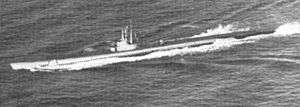USS Runner (SS-476)
USS Runner (SS/AGSS-476), a Tench-class submarine, was the second ship of the United States Navy to be named for the runner, an amberfish inhabiting subtropical waters. Her keel was laid down on 10 July 1944 by the Portsmouth Naval Shipyard of Kittery, Maine. She was launched on 17 October 1944 sponsored by Mrs. R.H. Bass, the wife of the prospective commanding officer, and commissioned on 6 February 1945 with Commander R.H. Bass in command.
 | |
| History | |
|---|---|
| Builder: | Portsmouth Naval Shipyard, Kittery, Maine[1] |
| Laid down: | 10 July 1944[1] |
| Launched: | 17 October 1944[1] |
| Commissioned: | 6 February 1945[1] |
| Decommissioned: | 29 June 1970[1] |
| Stricken: | 15 December 1971[1] |
| Fate: | Sold for scrap, 19 June 1973[1] |
| General characteristics | |
| Class and type: | Tench-class diesel-electric submarine[2] |
| Displacement: | |
| Length: | 311 ft 8 in (95.00 m) [2] |
| Beam: | 27 ft 4 in (8.33 m) [2] |
| Draft: | 17 ft 0 in (5.18 m) maximum [2] |
| Propulsion: | |
| Speed: | |
| Range: | 11,000 nautical miles (20,000 km) surfaced at 10 knots (19 km/h) [6] |
| Endurance: |
|
| Test depth: | 400 ft (120 m) [6] |
| Complement: | 10 officers, 71 enlisted [6] |
| Armament: |
|
World War II service
After shakedown and preliminary training off the Atlantic coast, she departed New London 5 April 1945, and arrived at Pearl Harbor on 21 May 1945, after intensive training at Key West, Florida, and Balboa, Panama. Her first war patrol was off the east coast of Honshū, Japan, where her primary mission was to scout for the presence of defensive minefields guarding the Japanese home islands. On 10 July while on patrol in the Sea of Japan, she intercepted two worthwhile targets, a tanker and a minesweeper. The tanker and her two escorts escaped the spread of torpedoes fired at them, but Japanese minesweeper W-27 was splintered by three of Runner's torpedoes. Before departing station, Runner received 16 downed aviators from Gabilan (SS-252) and Aspro (SS-309) for transfer to Guam, where she arrived on 24 July.
Her second patrol began a week prior to the Japanese capitulation and by the time Runner arrived on station off the east coast of Honshū, peace had come. Runner, with ten other US submarines entered Tokyo Bay on 31 August and represented the US submarine service at the formal surrender ceremonies. Runner and her sister submarines departed Japan on 3 September, arriving Pearl Harbor on 12 September. She continued east until reaching New London, Connecticut, on 6 October. A few weeks later, in company with other vessels of Submarine Squadron 6, Runner proceeded south arriving for duty at Balboa, Panama, on 14 February 1946. For the next three years, Runner was based at Panama and participated in annual fleet exercises in the Caribbean Sea.
Post World War II service
In June 1949, she was reassigned to Norfolk, Virginia, her base for the next seven years. In the autumn of 1957, Runner participated in North Atlantic NATO exercises, visiting ports in France and England. Homeported in San Juan, Puerto Rico, from July 1958 to July 1959, she operated in the Caribbean Sea as a Regulus missile guidance submarine.
.jpg)
Returning to Norfolk, Virginia, in July 1959, Runner operated with the fleet along the Atlantic coast for the next three years. She deployed to the Mediterranean Sea from January to early May 1962, operating with United States and NATO units. The remainder of 1962 was taken up with local ASW exercises and overhaul.
Throughout 1963 and 1964, she engaged in various antisubmarine warfare exercises in the western Atlantic. The summer of 1964 was spent in the Great Lakes, training Naval Reservists. After operating with the fleet in the spring of 1965, she entered Norfolk Naval Shipyard for overhaul. In 1966, operations included services for ASW exercises, type training, and participation in Exercise Springboard in the early spring. Runner deployed to the Mediterranean Sea with the Sixth Fleet from 8 July to 28 October 1966. School services for future submariners occupied most of 1967.
The year 1968 commenced with Runner providing services for Underwater Demolition Team school at Little Creek, Virginia, and ASW training off the East Coast. On 4 April 1968, Runner departed on her last Mediterranean Sea deployment. She returned to Norfolk, Virginia, on 31 July having visited ports in Spain and Portugal, and participating in NATO Exercise Dawn Patrol.
On 25 January 1969, Runner was decommissioned at the Boston Naval Shipyard, and towed to the Great Lakes Naval Training Station, where she was redesignated AGSS-476 and served as a Naval Reserve Training vessel until stricken from the Naval Vessel Register on 15 December 1971.
Runner received one battle star for World War II service.
References
- Friedman, Norman (1995). U.S. Submarines Through 1945: An Illustrated Design History. Annapolis, Maryland: United States Naval Institute. pp. 285–304. ISBN 1-55750-263-3.
- Bauer, K. Jack; Roberts, Stephen S. (1991). Register of Ships of the U.S. Navy, 1775-1990: Major Combatants. Westport, Connecticut: Greenwood Press. pp. 280–282. ISBN 0-313-26202-0.
- Bauer, K. Jack; Roberts, Stephen S. (1991). Register of Ships of the U.S. Navy, 1775–1990: Major Combatants. Westport, Connecticut: Greenwood Press. pp. 275–282. ISBN 978-0-313-26202-9.
- U.S. Submarines Through 1945 pp. 261–263
- U.S. Submarines Through 1945 pp. 305–311
- U.S. Submarines Through 1945 pp. 305–311
This article incorporates text from the public domain Dictionary of American Naval Fighting Ships. The entry can be found here.